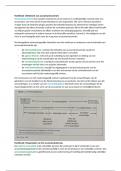Samenvatting
Theories of Entrepreneurship & Innovation - course summary
- Instelling
- Universiteit Van Amsterdam (UvA)
Descriptive summaries of all the video lectures and articles of the course divided by weeks. At the beginning of every week you have the summary of the videos, which gives you an idea of the main topics of that week, and after you can find detailed summaries for the mandatory articles.
[Meer zien]













